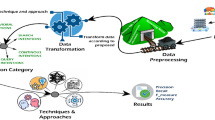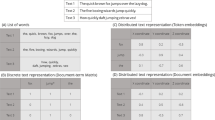Abstract
Intention Analysis is a computational task that analyzes people’s desires, wishes, and attitudes from user-generated texts. This sub-field of text mining has recently attracted research interest. This research paper provides an overview and an analysis of the latest studies in this field. These studies were categorized and summarized according to their contributions and the techniques they used. Several proposed approaches and some real applications were investigated in depth and presented in detail. Moreover, some related fields to intention analysis such as Transfer Learning (TL), Spam Detection (SD), and Building Resources (BR) were discussed in this survey of the literature dedicated to Intention Analysis. The aim of this survey is to give a comprehensive view of the intention analysis field supported by a number of graphics and summary tables about the literature. The paper concludes by identifying a number of research topics that can be promising for future research.





Similar content being viewed by others
References
Bach, N.X., Le, C.L., & Tu, M.P. (2017). Cross-domain intention detection in discussion forums. In Proceedings of the Eighth International Symposium on Information and Communication Technology (pp. 173–180): ACM.
Banerjee, N., Chakraborty, D., Joshi, A., Mittal, S., Rai, A., & Ravindran, B. (2012). Towards analyzing micro-blogs for detection and classification of real-time intentions. In ICWSM.
Beitzel, S.M., Jensen, E.C., Lewis, D.D., Chowdhury, A., & Frieder, O. (2007). Automatic classification of web queries using very large unlabeled query logs. ACM Transactions on Information Systems (TOIS), 25(2), 9.
Benczúr, A., Bíró, I., Csalogány, K., & Sarlós, T. (2007). Web spam detection via commercial intent analysis. In Proceedings of the 3rd international workshop on Adversarial information retrieval on the web (pp. 89–92): ACM.
Bhargava, A., Celikyilmaz, A., Hakkani-Tür, D., & Sarikaya, R. (2013). Easy contextual intent prediction and slot detection. In 2013 IEEE International conference on acoustics, speech and signal processing (pp. 8337–8341): IEEE.
Carlos, C.S., & Yalamanchi, M. (2012). Intention analysis for sales, marketing and customer service. In Proceedings of COLING 2012: Demonstration Papers. The COLING 2012 Organizing Committee. http://www.aclweb.org/anthology/C12-3005 (pp. 33–40). Mumbai, India.
Carvalho, V.R. (2008). Modeling intention in email. PhD thesis, Springer.
Castellanos, M., Hsu, M., Dayal, U., Ghosh, R., Dekhil, M., Ceja, C., Puchi, M., & Ruiz, P. (2012). Intention insider: discovering people’s intentions in the social channel. In Proceedings of the 15th International Conference on Extending Database Technology (pp. 614–617): ACM.
Castillo, C., Donato, D., Becchetti, L., Boldi, P., Leonardi, S., Santini, M., Vigna, S., & et al. (2006). A reference collection for web spam. In SIGIR Forum, (Vol. 40 pp. 11–24).
Chen, Y.-N., Hakkani-Tür, D., & He, X. (2016). Zero-shot learning of intent embeddings for expansion by convolutional deep structured semantic models. In IEEE International Conference on Acoustics, Speech and Signal Processing (ICASSP) (pp. 6045–6049): IEEE.
Chen, Z., Liu, B., Hsu, M., Castellanos, M., & Ghosh, R. (2013). Identifying intention posts in discussion forums. In Proceedings of the 2013 conference of the North American chapter of the association for computational linguistics: human language technologies (pp. 1041–1050).
Chengcheng, Z., Haruhiko, S., Satoshi, O., & Masahito, K. (2015). Inferring intentions of twitter users to visit places. In Proceedings of the International MultiConference of Engineers and Computer Scientists, Vol. 1.
Costello, C., Lin, R., Mruthyunjaya, V., Bolla, B., & Jankowski, C. (2018). Multi-layer ensembling techniques for multilingual intent classification. arXiv:1806.07914.
Dai, H.K., Zhao, L., Nie, Z., Wen, J.-R., Wang, L., & Li, Y. (2006). Detecting online commercial intention (oci). In Proceedings of the 15th international conference on World Wide Web (pp. 829–837): ACM.
Ding, X., Liu, T., Duan, J., & Nie, J.-Y. (2015). Mining user consumption intention from social media using domain adaptive convolutional neural network. In AAAI, (Vol. 15 pp. 2389–2395).
Duan, J.-W., Chen, Y.-H., Liu, T., & Ding, X. (2015). Mining intention-related products on online q&a community. Journal of Computer Science and Technology, 30 (5), 1054–1062.
Fu, B., & Liu, T. (2013). Weakly-supervised consumption intent detection in microblogs. Journal of Computational Information Systems, 6(9), 2423–2431.
Goldberg, A.B., Fillmore, N., Andrzejewski, D., Xu, Z., Gibson, B., & Zhu, X. (2009). May all your wishes come true: A study of wishes and how to recognize them. In Proceedings of Human Language Technologies: The 2009 Annual Conference of the North American Chapter of the Association for Computational Linguistics (pp. 263–271): Association for Computational Linguistics.
Hamroun, M., Gouider, M.S., & Said, L.B. (2015). Lexico semantic patterns for customer intentions analysis of microblogging. In 2015 11th international conference on Semantics, knowledge and grids (SKG) (pp. 222–226): IEEE.
Hamroun, M., Gouider, M.S., & Said, L.B. (2016). Large scale microblogging intentions analysis with pattern based approach. Procedia Computer Science, 96, 1249–1257.
Hassan, K., Ali, E., Chantal, S.-Du., & Said, T. (2008). Ontointention: an ontology for documents intentions. In Second international conference on Research challenges in information science, 2008. RCIS 2008 (pp. 301–306): IEEE.
Hollerit, B., Kröll, M., & Strohmaier, M. (2013). Towards linking buyers and sellers: detecting commercial intent on twitter. In Proceedings of the 22nd International Conference on World Wide Web (pp. 629–632): ACM.
Jansen, B.J., & Booth, D. (2010). Classifying web queries by topic and user intent. In CHI’10 Extended abstracts on human factors in computing systems (pp. 4285–4290).
Kanso, H., Elhore, A., Soule-Dupuy, C., & Tazi, S. (2008). Recognition and extraction of intentions based on ontology. In 3rd international conference on Information and communication technologies: From theory to applications, 2008. ICTTA 2008 (pp. 1–5): IEEE.
Kato, T., Nagai, A., Noda, N., Sumitomo, R., Wu, J., & Yamamoto, S. (2017). Utterance intent classification of a spoken dialogue system with efficiently untied recursive autoencoders. In Proceedings of the 18th Annual SIGdial Meeting on Discourse and Dialogue (pp. 60–64).
Khan, F., Borah, S., & Pradhan, A. (2016). Mining consumption intent from social data: A survey. International Journal of Computer Applications, 975, 8887.
Khodabandelou, G., Hug, C., Deneckere, R., & Salinesi, C. (2013). Supervised intentional process models discovery using hidden markov models. In 2013 IEEE seventh international conference on Research challenges in information science (RCIS) (pp. 1–11): IEEE.
Korpusik, M., Sakaki, S., Chen, F., & Chen, Y.-Y. (2016). Recurrent neural networks for customer purchase prediction on twitter. In CBREcsys@ recsys (pp. 47–50).
Labidi, N., Chaari, T., & Bouaziz, R. (2016). An nlp-based ontology population for intentional structure. In International conference on intelligent systems design and applications (pp. 900–910): Springer.
Lafferty, J., McCallum, A., & Pereira, F.C.N. (2001). Conditional random fields: Probabilistic models for segmenting and labeling sequence data.
Lee, C.-H.L., & Liu, A. (2005). Modeling the query intention with goals. In 19th international conference on Advanced information networking and applications, 2005. AINA 2005, (Vol. 2 pp. 535–540): IEEE.
Li, C., Du, Y.J., & Wang, S. (2017). Mining implicit intention using attention-based rnn encoder-decoder model. In International conference on intelligent computing (pp. 413–424). Springer.
Liu, B. (2015). Sentiment analysis: Mining opinions, sentiments, and emotions. Cambridge University Press.
Ting, LIU, Bo, FU, & YiHeng, CHEN. (2015). Detecting consumption intention based on graph ranking in social media. Scientia Sinica Informationis, 45(12), 1523.
Liu, Y., Han, K., Tan, Z., & Lei, Y. (2017). Using context information for dialog act classification in dnn framework. In Proceedings of the 2017 Conference on Empirical Methods in Natural Language Processing (pp. 2170–2178).
Ngo, T.-L., Pham, K.L., Takeda, H., Pham, S.B., & Phan, X.H. (2017). On the identification of suggestion intents from vietnamese conversational texts. In Proceedings of the Eighth International Symposium on Information and Communication Technology (pp. 417–424): ACM.
Okamoto, M., Yang, Y., & Ishida, T. (2001). Wizard of oz method for learning dialog agents. In International workshop on cooperative information agents (pp. 20–25): Springer.
Pan, S.J., & Yang, Q. (2010). A survey on transfer learning. IEEE Transactions on knowledge and data engineering, 22(10), 1345–1359.
Ramanand, J., Bhavsar, K., & Pedanekar, N. (2010). Wishful thinking: finding suggestions and’buy’wishes from product reviews. In Proceedings of the NAACL HLT 2010 Workshop on Computational Approaches to Analysis and Generation of Emotion in Text (pp. 54–61): Association for Computational Linguistics.
Šebalj, D., Franjković, J., & Hodak, K. (2017). Shopping intention prediction using decision trees. Millenium-Journal Of education, Technologies, and Health, 2(4), 13–22.
Shimada, K., Iwashita, K., & Endo, T. (2007). A case study of comparison of several methods for corpus-based speech intention identification. In Proceedings of the 10th Conference of the Pacific Association for Computational Linguistics (PACLING2007) (pp. 255–262).
Wang, J., Cong, G., Zhao, W.X., & Li, X. (2015). Mining user intents in twitter A semi-supervised approach to inferring intent categories for tweets. In AAAI (pp. 318–324).
Wu, X., & He, Z. (2011). Identifying wish sentence in product reviews. Journal of Computational Information Systems, 7(5), 1607–1613.
Xia, C., Zhang, C., Yan, X., Chang, Y., & Yu, P.S. (2018). Zero-shot user intent detection via capsule neural networks. arXiv:1809.00385.
Zhang, C., Fan, W., Du, N., & Yu, P.S. (2016). Mining user intentions from medical queries: A neural network based heterogeneous jointly modeling approach. In Proceedings of the 25th International Conference on World Wide Web (pp. 1373–1384): International World Wide Web Conferences Steering Committee.
Zhang, S., & Wang, N. (2016). Classification model for intent mining in personal website based on support vector machine. International Journal of Database Theory and Application, 9(2), 145–152.
Zhao, X.W., Guo, Y., He, Y., Jiang, H., Yuexin, W., & Li, X. (2014). We know what you want to buy: a demographic-based system for product recommendation on microblogs. In Proceedings of the 20th ACM SIGKDD international conference on Knowledge discovery and data mining (pp. 1935–1944): ACM.
Author information
Authors and Affiliations
Corresponding author
Additional information
Publisher’s note
Springer Nature remains neutral with regard to jurisdictional claims in published maps and institutional affiliations.
Rights and permissions
About this article
Cite this article
Hamroun, M., Gouider, M.S. A survey on intention analysis: successful approaches and open challenges. J Intell Inf Syst 55, 423–443 (2020). https://doi.org/10.1007/s10844-020-00604-x
Received:
Revised:
Accepted:
Published:
Issue Date:
DOI: https://doi.org/10.1007/s10844-020-00604-x




